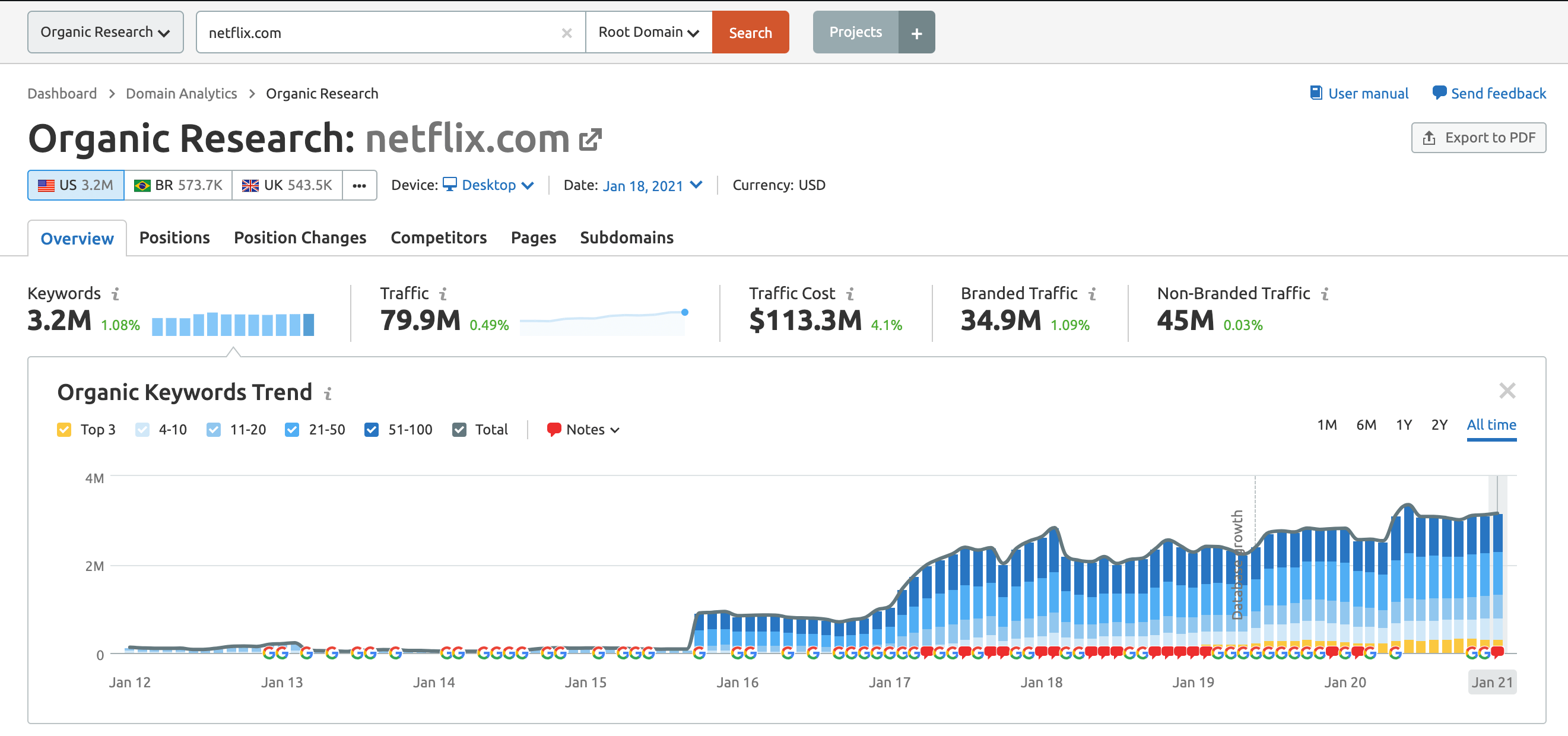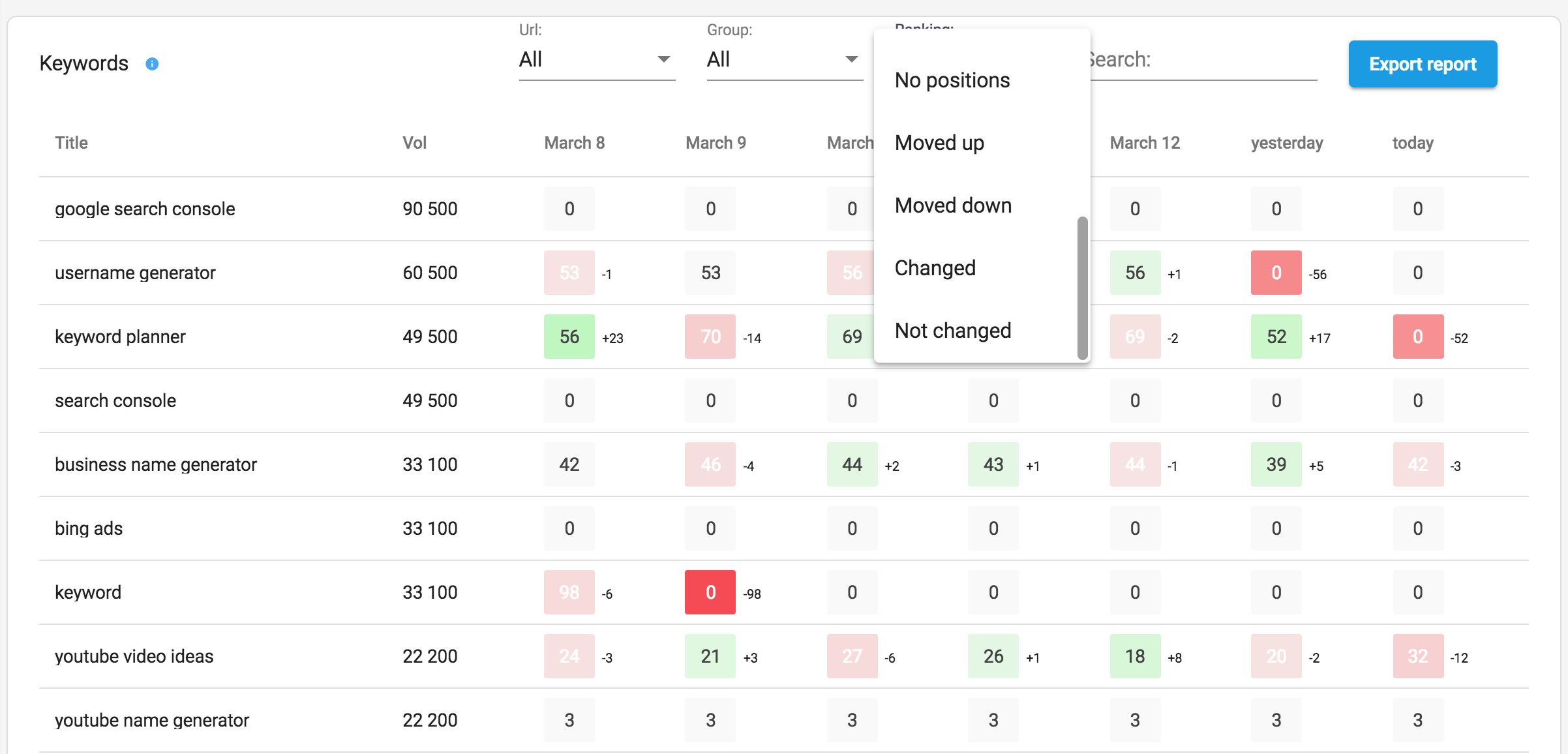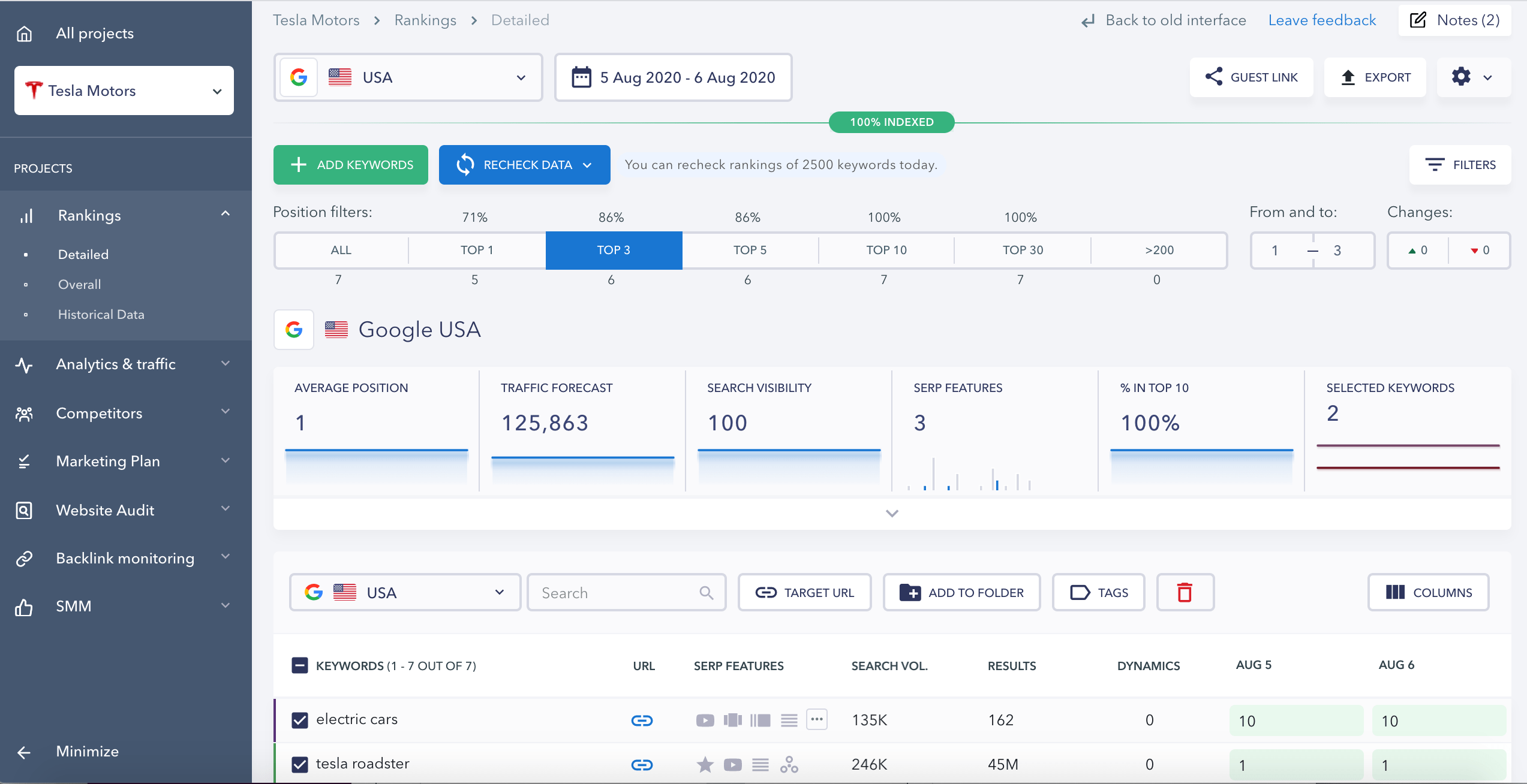Knowing how to track your SEO rankings is essential to driving a continuous flow of organic traffic to your website.
In this guide, I will teach you how to find Google keyword rankings and what free tools are available to help.
Best Tools To Check Your Keyword Rankings in Google
- Google Search Console Performance Reports
- Manually Checking Google (With Personalized Search Disabled)
- SEMRush Organic Research Report
- SiteChecker Rank Tracker
- SERanking Keyword Rank Tracker
1. Google Search Console Performance Reports
The first tool you can use to check your keyword rankings is the Google Search Console. The platform is free and serves as a centralized hub for managing and monitoring your website’s SEO performance.
To start using Search Console you must create an account using your Gmail or G-Suite email address.
Once you have created your account, you need to add your website as property before you can monitor your keyword performance.
There are several ways you can verify your website in Google Search Console.
The easiest method is to link the Google Analytics account that you are using to collect data on your website’s traffic.
Because setting up the Google Analytics account would have already involved adding a tracking code to the website, when you are able to authorize access to the Analytics account, Google can verify that you own the site.
If you do not have a Google Analytics account, you will have to use one of the other verification methods. Some of the options include adding an HTML file or tag, updating your DNS records, or using Google Tag Manager.
To check your keyword rankings in Google Search Console go to the “Performance” tab. Upon arriving on the page you will see an interactive chart with several important stats including:
- Total clicks
- Total impressions
- Average click-through rate (CTR)
- Average position

You can select or deselect any metric, and the body of the chart will show how each chosen metric is trending over the specified timeframe. The default setting for the chart is 3 months, but you can change this period to whatever you like.
Scrolling down the page, you will find the Queries tab which contains a list of every keyword your website has generated a ranking for during the specified time period. It will display the average ranking, CTR, and the total number of clicks.
You can also view your keyword performance for particular pages by clicking on the “Pages” button on the report.

Here you will see the total stats for all your ranking pages. When you click on a page you can see which queries that page is ranking for as well as the countries and devices driving the most impressions and clicks.
2. Manually Checking Google (With Personalized Search Disabled)
Possibly the most direct way to check your keyword rankings is to manually search for them in Google yourself.
Before you pop open another tab and enter one of your target terms, be aware that there are some steps that you need to take to ensure that you are getting the most accurate results.
If you make a search in the same browser that you normally use for Google, without clearing your cookies you are not going to get the same results that a random searcher would.
To get the most accurate results, you’ll need to open a browser window that does not enable cookie tracking. In Google Chrome, this is an Incognito Window, in Firefox, it is a Private Window.
Be aware that even if you clear your cookies, or use a private browser, Google’s default setting is to personalize search results. When doing so it will take into account your geo-location which can be derived from your IP address, as well as your previous search history if you are somehow still logged into your Google account.
On the Google homepage, click on the “Settings” button, which can be found down in the bottom right corner of the page. If you have already entered a search, the “Settings” button will appear towards the top of the page near the search bar.
From the settings page, look for a section called “Private Results”. You will need to select “do not use private results”.

When private results are enabled Google will give you personalized results when ranking pages.
Once you have disabled personalized results, you’ll want to select the location that you want to evaluate the results for. At the bottom of the settings pages, there will be a section called “Region Settings”. Here you can select the country you want Google to use when populating the results.

After you have taken all these steps to ensure that you are generating accurate results, you can begin searching the keywords you want to evaluate. When you enter a search term, the results page should show the pure rankings within the Google index for that particular keyword.
You will need to scroll through the results and possibly visit page two and beyond before you find your website (if you rank for that term at all). Make sure to record the results that you find otherwise you won’t be able to track your performance over time.
Needless to say, this is a bit of a cumbersome method of checking your keyword performance. You will likely have to sift through multiple pages just to find where you rank for a single term. If you want to check multiple terms, you will have to repeat the process again for each keyword.
3. SEMRush Organic Research Report
SEMRush provides a comprehensive suite of SEO tools designed to help businesses plan and monitor every aspect of their search engine performance efficiently.
Among these tools is the Organic Research Report that can tell you everything you will need to know about your keyword rankings in Google.
The tool is broken into different sections which you can toggle between to analyze your keyword performance from a different perspective.
The report starts on the Overview tab. Here you will find the total number of keywords the site organically ranks for and the estimated number of visitors likely to visit the website over the next month given its current ranking positions.

There is also a graph that shows the trend of how many keywords the site has ranked for historically.
In the Positions section, you will find a complete list of all the keywords for which the website is ranking. This includes:
- The current position for that keyword
- Any changes in ranking
- The average monthly search volume over the past year
- A keyword difficulty score that estimates how hard it is to rank for that keyword
- The URL of the page ranking for that keyword.
The Competitors section gives an overview of the performance of the website’s primary search competitors. It does this by comparing how many common keywords the website shares with a particular competitor to calculate a Competition Level metric which is measured as a percentage (up to 100%).
The Pages section details how well each of your web pages is performing in Google.
On the list of the pages attracting organic visitors to your website you can see the total organic traffic for each page, the percentage of total traffic to the page that comes from organic search, and the total number of keywords a page is ranking for.
Overall, SEMrush is a powerful tool for checking your SEO rankings in Google. If you want to make the most of everything the solution has to offer, you will need to sign up for a paid plan. SEMRush does come with a free version but it limits the amount of data you are able to access.
For instance, if you open the Organic Research Report for your website with the free plan you can only see the organic position for ten of the keywords.
4. SiteChecker Rank Tracker
SiteChecker also provides a comprehensive suite of digital marketing solutions.
With the Rank Tracker tool, you can track your website’s keywords ranking to see where you stand and how your positioning is changing over time.
To get started, you add the keywords that you want to track to the tool. You’ll need to specify the location and the language of the searcher in the settings for each keyword.

After you have added your keywords, Rank Tracker begins collecting position data. Results are typically available within a few hours. Going forward, the data is updated once a day.
Once the data comes in, you will see graphs showing the overall trend for the provided keywords. There will also be a chart showing the daily ranking for each keyword as well as the difference in position from the previous day.
When you click on a keyword you can see the SERP results for that term and where your competitors are ranking.
Sitechecker has a free plan that grants access to some of its tools, however, this does not include the Rank Tracker. If you want to use Rank Tracker to check your keyword performance, you will need to upgrade to a paid plan.
There are three options available which start at $19 per month when billed monthly. Opting for annual billing will lower the cost by 20%.
Sitechecker offers users a free trial to test the platform before committing.
5. SERanking Keyword Rank Tracker
SERanking is another suite of SEO tools that features a robust keyword ranking tracker.
Upon creating your account you will need to create a project with your website before you can track your keyword performance.
The first step is to add the domain you want to track. Next, you will add the keywords you want to track. You can do this manually either by typing them in one by one or importing a file with multiple keywords.
SERanking also has a suggestions box that you can quickly use to add keywords to the list. This box is automatically populated with keywords that the site is already ranking.
The next step is to specify the search engines you want to track. Naturally, Google will be the primary choice for most, but you can also add Bing, Yahoo, or Yandex if you choose.
After that, you will add any competitors you want to track. Like keywords, SERanking can suggest competitors for you.

Finally, you can choose to link your Google Analytics and Google Search Console accounts before the project goes live.
From there, go to the Rankings section on the left-hand menu to begin tracking your keyword performance. You will see a list of all the keywords you added, the monthly search volume, and your current position for each term.
The overview displays your average position, estimated traffic based on your ranking, and the percentage of keywords ranking in the top 10.
Down the page, you will see a list of the keywords you have added for tracking. If you are currently ranking for a keyword, the URL of the ranking page will be present. When you click on the SERP Competitors button for a keyword, you are taken to a list of the top 100 ranking pages for that term.
SERanking doesn’t have a totally free plan but it does give users more flexibility when choosing their paid options. You can pay in 1 month, 6 months, or annual installments. You can also choose how long your ranking tracking is updated with a 1 day, 3 days, or weekly period.
Best Tips to Improve Your Google Rankings
- Provide Content That Matches the Search Intent
- Optimize your Search Snippets
- Build High-Quality Links from Relevant Websites
- Optimize for Core Web Vitals
1. Provide Content That Matches the Search Intent
Optimizing your content for search intent is one of the best ways to boost your organic rankings.
Search intent is the reason behind a search for a specific term in a search engine. It is typically broken into four main categories:
- Informational: The searcher is seeking information on a subject like “How to start a blog”
- Navigational: The searcher is entering a term that will lead them to a specific page like “Amazon”
- Commercial: The searcher is looking for something they are interested in buying like “Protein Powder”
- Transactional: The searcher is trying to complete a purchase like “Buy protein powder online”
The reason optimizing for search intent is so important is because Google looks to provide searchers with the most relevant results when ranking content. If it is clear that somebody wants to buy something when searching a specific phrase, Google isn’t going to rank a purely informative piece of content at the top for that keyword.
When you know the search intent behind a keyword, you can fine-tune your content to give the searcher (and by extension Google) exactly what they want.
2. Optimize your Search Snippets
Featured snippets often appear at the top of the search results. Not only do they receive prominent positions, but they provide a more rich result which tends to lead to better click-through rates.
Google’s goal with featured snippets is to answer the searcher’s query instantly.
Featured snippets generally appear in one of the following formats:
- Paragraph
- Listicles
- Table
Optimizing your content to gain a featured snippet starts with keyword research. Certain types of search queries are more likely to generate a featured snippet than others. Research has shown that long-tail keywords generate more featured snippets than short-tail searches.
Look for keywords that use question-type language such as “what, why, and how”.
You can also take advantage of some of the tools previously mentioned on this list to see which keywords have historically triggered featured snippets.
For example, using the SEMRush Organic Research Report, you can select a keyword and see which SERP features (featured snippets, people also ask, video, etc) are normally included in the results.
Once you have identified keyword opportunities for featured snippets, you’ll have to optimize your content and on-page SEO to improve your chances of earning the placement.
Look to answer the question concisely and accurately. The answers included in featured snippets are not normally that long, so you should try to answer the question in a single paragraph. You’ll also want to include the question itself somewhere on the page, usually as a subheading.
3. Build High-Quality Links from Relevant Websites
High-quality backlinks remain one of the most important SEO factors for all kinds of websites.
Backlinks essentially serve as a mark of approval from one website to another. When a website links to your website it sends a signal to Google that the other site thinks highly of your content and is thus willing to link to it.
If you can get many sites to link back to you, Google will notice this and deem your content to be high-quality and will rank it accordingly.
Keep in mind that not all links are the same. Backlinks from high-quality and authoritative sites are more valuable than those from small, unpopular sites.
When you link out to a different site you are essentially passing a bit of your page authority onto the page you are linking to. Because of this, pages with higher domain authority and page authority can give a much bigger boost to SEO when they link to another website.
Gaining high-quality links is challenging, but there are plenty of effective approaches you can take.
The first tactic you should use in your link building campaign is guest posting. Guest posting is when you write a blog post for another website for free. In most cases, the guest site will allow you at least one link back to your website.
Guest posting is one of the most effective link building strategies because it provides the other website something of value, free of charge. It is easy for a site owner to reciprocate your offer by allowing you to link back to your site because it doesn’t cost them anything. Look for websites in your niche that accept guest posts and come up with a list of potential topics you could write about.
Not all websites will openly disclose if they accept guest posts so you may find it useful to conduct cold outreach to other high authority sites in your niche.
Other effective link building tactics include:
- Broken link building: This is where you find broken links on relevant sites and reach out to the owner to let them know the link is dead and suggest replacing it with a link to a similar page on your website.
- Skyscraper content: With this tactic, you find content that is ranking well and has a lot of high-quality backlinks. You create your own content on the subject, making your page considerably better than the competitors.
Then you reach out to the authoritative sites that are linking to the competitor letting them know that you have created something more in-depth and that they should consider linking to you instead.
To perform these two link-building strategies, you will need powerful SEO tools like SEMRush or Ahrefs.
4. Optimize for Core Web Vitals
Core Web Vitals are a set of technical factors that Google views as important for determining how a webpage’s performance affects the user experience. The three metrics included in Core Web Vitals are:
- Largest contentful paint: How long it takes for your page to load from the perspective of the user
- First input delay: The time it takes for users to interact with your page
- Cumulative layout shift: How stable a page is as it loads (meaning things aren’t moving around)
Google includes page experience as a ranking factor so knowing how to improve these metrics will help improve your website’s SEO rankings.
You can access the Core Web Vitals report within Google Search Console. The report will give you an overview of how different pages are performing, categorizing them as either good URLs, URLs that need improvement, or poor URLs.
If there isn’t enough data in Search Console to provide a report for your pages, you can use the PageSpeed Insights tool to test each page individually.
Here are some steps you can take to improve your Core Web Vitals:
- Minimize third-party scripts.
- Remove large page elements
- Minimize JavaScript
- Use browser caching
Key Learnings
Knowing how to check your keyword rankings in Google is an important part of any SEO strategy.
There are many tools available, both free and paid, to help you with this endeavor.
The first tool you should use is Google Search Console. You can ensure that the data is accurate as it comes from Google itself. With Search Console, you can see an overview of your total performance while also analyzing keywords and pages on an individual level.
There are several SaaS companies that provide a robust suite of SEO tools that include a keyword tracker among them. The most notable are SEMRush, Sitechecker, and SERanking. With these tools, you can see where you rank in Google and how your performance is changing over time. You can also easily track your competition to see where they are ranking.
If you don’t want to use a dedicated tool, you can always manually check your rankings in Google. This is more tedious and will require using a private browser with personalized results disabled.
Once you are able to see your SEO rankings you can begin making improvements as necessary. The best ways to boost your Google rankings are to provide content that matches the search intent, optimize your search snippets, build high-quality links from relevant websites, optimize for core web vitals.
By implementing these tactics and actively tracking your position, you should see your SEO rankings improve over time.




Thanks for sharing these free tools which help to check our keyword rankings in Google. The point where you discuss the optimize our search snippets is very helpful to improve our Google ranking.
Hi Brack
Thanks a lot for your comment.
Alex
Great post. Very useful. Thanks for sharing free tools for checking keyword ranking.
Hi Mera
Thanks a lot for your comment. Glad I could help!
Alex